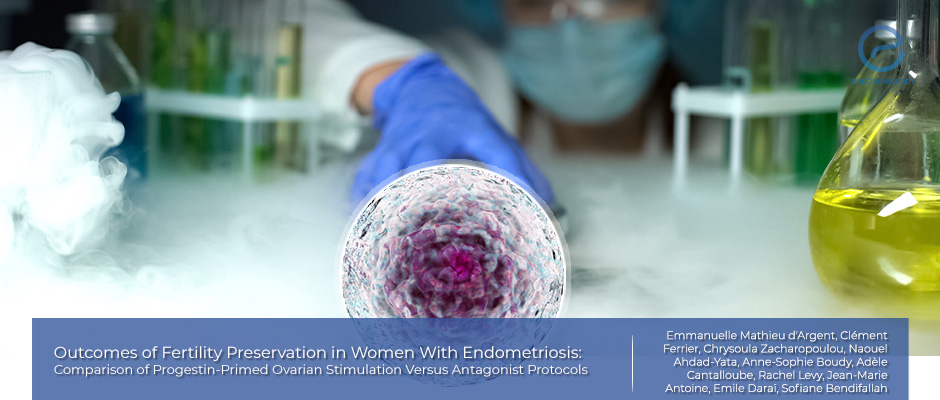Fertility preservation protocols in women with endometriosis
Apr 13, 2020
Fertility preservation recommendation for patients with endometriosis.
Key Points
Highlights:
- Progestin-primed ovarian stimulation and antagonist protocols for fertility preservation can be applied to women with endometriosis, with similar feasibility and effectivity.
Importance:
- The women with endometriosis who will undergo fertility preservation procedures should be informed about all the advantages and the disadvantages of both protocols.
What’s done here?
- This article was conducted to clarify the differences between progestin-primed ovarian stimulation and antagonist protocols for fertility preservation outcomes.
- Women aged >40y, having endometriosis with ovarian cysts with altered ovarian reserve (antral follicle count <10, serum anti-Mullerian hormone level <2) were included.
- The dosage of gonadotropins was initiated according to BMI, antral follicle count and serum anti-Mullerian hormone levels of the patients.
- Progestin-primed group used daily oral progestin from the first or second day of the cycle, the antagonist protocol injected the GnRH antagonist daily from the 6th day of the cycle.
- The number of retrieved oocytes was the primary outcome. The secondary outcomes were the number of vitrified oocytes, the rate of ovarian hyperstimulation, cycle cancellation due to insufficient ovarian response and LH surge incidence.
Key results:
- A total of 108 women underwent fertility preservation procedures. Ninety-three (92.1%) had deep endometriosis, 36 (34.3%) had endometrioma.
- The clinical and demographic characteristics of the patients were similar between progestin-primed ovarian stimulation and antagonist protocol.
- There was also no significant difference between the two groups regarding the number of retrieved and vitrified oocytes and direct medical costs.
- However, the difference was the cost of medical treatment: Progestin treatment was cheaper than the GnRH antagonist.
- The number of retrieved oocytes was associated with age, prior ovarian surgery and serum anti-Mullerian hormone levels.
Strengths and Limitations
- This is the largest observational cohort study investigating the fertility preservation outcomes by comparing progestin-primed ovarian stimulation and antagonists.
- Limitations are, the study not being a randomized-controlled trial and the protocol chosen by the patients.
- Most patients were using hormonal treatment before fertility preservation procedures.
- Oocyte quality and pregnancy outcomes were not evaluated.
- Also, direct non-medical and productivity costs were assumed as zero in the cost analysis.
Lay Summary
Infertility is one of the major symptoms in women with endometriosis. Childbearing at a delayed age is preferred by the majority of women recently who consult for the demand for fertility preservation procedures.
There are several techniques for fertility preservation such as ovarian cortex cryopreservation, freezing of embryos and oocyte cryopreservation that has been accepted as the best option due to lower negative impact on ovarian reserve and lower associated morbidity. Although there are many publications about the outcomes of fertility preservation in women with cancer, the study about the most effective stimulation fertility preservation protocol has not been performed.
Mathieu d’Argent et al, from France, published a study titled “Outcomes of fertility preservation in women with endometriosis: comparison of progestin-primed ovarian stimulation versus antagonist protocols” in the "Journal of Ovarian Research".
The authors sought to investigate the outcomes of fertility preservation by comparing two different protocols: progestin-primed ovarian stimulation and antagonist protocols. The number of retrieved and vitrified oocytes during the cycle, the rate of moderate/severe ovarian hyperstimulation, the rate of cycle cancellation due to insufficient ovarian response, the rate of LH surge incidence and the cost-effectiveness analysis were evaluated as the primary and secondary outcomes of the study.
The protocol for fertility preservation was chosen by the patients after receiving detailed information. There was no difference between the two groups in terms of the clinical and demographic characteristics of the patients, the number of retrieved and vitrified oocytes and all direct medical costs. However, GnRH antagonist treatment had a higher cost in the medico-economic analysis. Multivariate regression analysis showed that the number of retrieved oocytes was associated with age, prior ovarian surgery and serum anti-Mullerian hormone levels.
Although this study has several limitations, it added new information to the literature. As progestin-primed ovarian stimulation and antagonist protocols have similar effectivity and feasibility, both can be offered to women with endometriosis.
“Data should be collected on a continuous basis to further clarify indications for FP in the context of endometriosis, taking both the economic burden and success rates into consideration.” the authors added.
Research Source: https://pubmed.ncbi.nlm.nih.gov/32054493
cryopreservation endometriosis assisted-reproductive technology cost-effectiveness infertility retrieved oocytes vitrified oocytes

